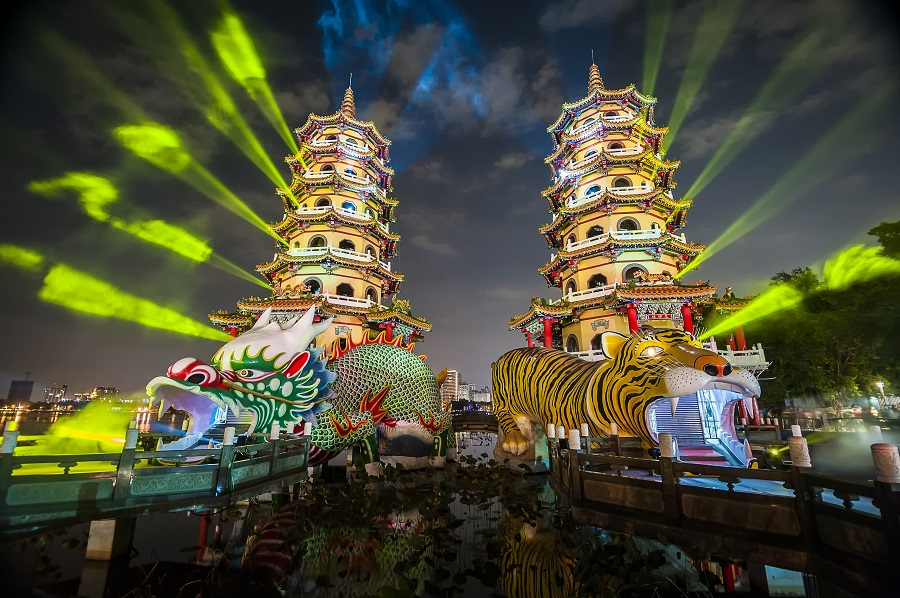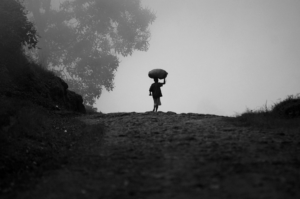The A Mei Tea House in Jiufen—a three-storey restaurant done with an exterior of darkened wood fringed with red, bulbous lanterns on the building’s façade—is a sight to behold in its own regard. The pleasure is increased for fans of the Japanese animated filmmaker Hayao Miyazaki who will immediately identify the building’s uncanny similarity with Spirited Away.
Nevertheless, it’s an association that Miyazaki himself has vigorously denied, The A Mei Tea House’s owner said. A tour of the restaurant includes a visit to a set of masks that bears a distinct appearance to the masked figure inside of the film, No Face, where they mention the film by name. It’s clear that Miyazaki’s denials have done little to convince the owners that his artistic property is distinct from the tea house.
Nor are the denials meaningful seemingly to visiting press who paid the site a visit before Oi Vietnam’s visit in October. A reporter from Vice filed a story in 2018 under this headline: “Eat All the Food from Spirited Away in this Taiwanese Town,” referring to the abundance of snacks inside Juifen’s tight, winding and—forgive the description—spirited alleyways as well as the A Mei Tea House’s undeniable similarities to the film.

Jiufen, Taiwan – A Mei Tea House at Jiufen Old Street in raining day, Taiwan. the famous tourist spot and popular scene in Spirited Away animation ghibli studio.
As a souvenir for our visit, A Mei Tea House gives us a postcard showing the exterior of the film at night. The red lanterns’ glow gives everything in the frame a reddish-orange hue and it all looks frankly like a famous anime film that allegedly has nothing to do with the tea house.
The tea house owners pointed out, however, that the lanterns are probably more closely associated with traditional Chinese decorations of the same style. The note makes explicit not just Jiufen but greater Taiwan’s place as a meeting point for various Asian cultures. Oi’s reporting was unable to settle the debate on whether or not Miyazaki took inspiration from the Japanese-style tea house in rural Taiwan, but rather what became evident at various site visits throughout the country was the nation’s inextricable ties to its nation neighbors to the north and west.
Chenggong Township in Taiwan’s Taitung County is a sleepy town nestled next to a mountain. The clear skies and vacant roads give it an almost Coloradolike feel, except for the Chinese script on the business signage. But even with the language differences, an air of familiarity prevails over the village. Perhaps its town’s removed, rural—Chenggong is a full 217 miles (349 kilometers) from the capital, Taipei—and related lack of tourist- and visitorfacing infrastructure that gives a sort of plainness and normalness. It’s special, yet nothing is presented as special. The language is untranslated, the experience is unmediated, yet it clearly means something.
It’s in this unassuming, secretkeeping quiet locale that mochi maker Dong Ban Xiang sits. At the intersection of two sloping roads within walking distance of an active local produce market that’s bustling by mid-morning. Inside, owner Liu June Ling work making the traditional hakka treat, the third generation of his family to maintain the culinary tradition. The mochi shop was originally opened by his grandmother.

Hakka
Maybe you’ve tried mochi before. Maybe you’ve tried a recipe that placed mochi firmly in the dessert camp: chewy, almost sticky but super sweet. It’s the kind of thing you’d need to follow with a drink of water to clear the palette. Those are not the Liu family’s mochis. Greeting traveling press in a visit, the owner lays out the restaurant’s treat: a white mochi cake with sesame inside, a red mochi covered in a layer of peanuts. The glutinous treats have an overall neutral flavor that doesn’t overpower another light flavor like peanuts. He serves them with a sticky rice pudding with pork and steamed brown sugar rice cakes.
Mochi was originally believed to be a type of food for the gods by the Japanese who created and popularized it. The ascendance of this belief tracks with a belief that the mochi could be used to enhance the eater’s strength—a belief which led to the food’s popularity among samurai—and even build healthy teeth. How this Japanese dish came to be part of a food tradition belonging to an ethnicity that hails from southern China isn’t known exactly, but the Hakka adoption of another food traditional mirrors the Hakka adoption of Thai food. In certain parts of India, diners there eat a Hakka-nized Indian food.
Originally nomadic people of northern China, Hakka have over the years been spread out over the globe. The name Hakka in Chinese reflects this visitor status; The Chinese characters for Hakka (客家) literally means “guest families”. A Hakka saying: “Wherever there is sunshine … there are Hakka.”
Today, the Hakka are the second largest ethnic minority in Taiwan, about a fifth of the 4.6 million who live on the island. The Hakka were key allies in the fight to rid the island of Japanese invaders, which ended at the close of World War II. As a point of historical healing, the Japanese have worked to rehabilitating the symbols of their imperial past in Taiwan by, for example, converting one of their old military ports into the Sanxiantai ecological reserve. It’s also not uncommon to enjoy tea in a ceremonial manner that identified as distinctly Japanese.
Mochi is strongly identified as a Japanese dish, but in fact both Hakka and Japanese have their own take on the dish. The mochi prepared by Lui, with its crushed peanut exterior, is done in a Hakka style. A Japanese-style mocha might be sweeter, like the red rice-filled cake Lui also served for visiting press.
To a certain extent, asking whether or not Miyazaki borrowed from Jiufen is a bit arbitrary. The centuries intermingling between Japanese and Taiwanese, the presence of cultural intermediaries like the Hakka and Taiwan itself, make it clear that cross pollination likely occurred if not with Miyazaki then with someone who tutored him.
The question is a bit like asking whether the green, turtle-shaped mung rice cakes he served to us and other visiting press actually bring good luck. Something else is at work, something bigger may be at stake in the question. There is something more interesting than “true or false” as a feature to those questions. Exploring the governing logic behind asking a question like that seems equally if not more fruitful. The questions themselves deserve careful processing, something to chew on albeit slowly, like the foods of the mochi maker Lui.
Don’t Miss Out
Visitors to Taiwan will likely touch down in the country’s international airport near Taipei. If you’re looking for something more removed from the typical, consider taking the twohour journey to Lukang Township. There, you’ll find Wu Yi Hsiang Oyster Omelet. Enjoy its offering of oysters in a range of recipes: oyster omelets, oyster vermicelli stew and a sharp-yet-distinct oyster and ginger dish with wasabi sauce. The early fall months are the best time to go. The bigger oysters are available during the months of August and September. While you’re in town, stop by the Osmanthus Alley Humanities Tea House and sample the osmanthus cakes and tea made in this cozy shop, which was converted from a home to the business it is today. If you’ve never had osmanthus before as either a food or a drink, the slightly spicy, warm aroma that greets you as you enter the tea house will give you a good sense of what you’re about to get yourself into. This tea house is not only a business but a home base for a collective of local artists and creatives fostering homegrown talent—painters, designers and more—who sell their wares at this unique tea shop. This township is also the home of Dingtaixingg Cuisines, a quiet bakery that sells a selection of traditional steamed cakes. Select from a range of flavors: taro, matcha and even pumpkin. The cakes are said to be prepared in a way that removes toxins and promotes health. Enjoy these fluffy, low-fat cakes with a perfect pairing of brewed coffee.

Lukang, Taiwan – famous old street in Lukang town at Changhua county, Taiwan
Fun fact: Lukang Township gets its name from the Chinese word “lu” meaning “deer.” The region is famous for its deer population. The city was once a primary hub of the region’s deerskin trade.
If you’re going to make the trip out to Lukang, Donggang Township is just within reach to another couple hours away. The coastal city is renown for its offerings of seafood. Would you take a suggestion? Head to the Arong Square Seafood Flavor restaurant. Dine on the red coronet fish, a seafood delicacy only found here. Those who prefer to eat with their eyes first are in for a treat: the restaurant’s specialty dish is a bluefish tuna doused with a whiskey glaze that’s set aflame at the table. The resulting fish is gently cooked and still tender. The whiskey is aromatic but added a light bite to the creamy fish. Head to Jiazshen Seafood Restaurant to enjoy more of the region’s seafood in recipes particular to the area, like the fried tuna cake made with leeks served with a side of papaya in an arrestingly delicious passion fruit sauce. Be sure to try their fish filet in a soy and vinegar sauce, which has garnered the restaurant an award. The shrimp is served in a crispy cake known as a “beehive” for its appearance. This restaurant is owned by a fisher-turnedentrepreneur, a second-generation fisher who knows the catch best.
This township is also the home of the centuries-old Donglong Temple. This storied temple holds a collection of ornate carvings done as an homage to the gods guarding the seafarers the area harbored in the past as today. You’ll know this temple by its massive, gold leaf-covered gate. Once you’ve seen more of the city, head to Dongsheng Restaurant to savor the region’s crab and the harpodon macrochir, a kind of light, buttery fish that’s very trout-like in mouthfeel. You’ll hardly hear anyone call it by this scientific sounding name. Curiously, locals tend to refer to it as “that fish,” a name that’s perfectly teed up for the joke you’re itching to make with it.






